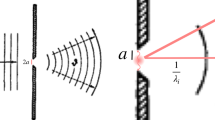Abstract
The usual definition of (non-contextual) hidden variables is found to be too restrictive, in the sense that, according to it, even some classical systems do not admit hidden variables. A more general concept is introduced and the term “approximate hidden variables” is used for it. This new concept avoids the aforementioned problems, since all classical systems admit approximate hidden variables. Standard quantum systems do not admit approximate hidden variables, unless the corresponding Hilbert space is 2-dimensional. However, an appropriate non-standard quantum system, which arises by focussing on momentum and position and neglecting the remaining observables, admits approximate hidden variables. Systems associated with JBW-algebras (resp. von Neumann algebras) and satisfying some mild conditions admit approximate hidden variables iff they are classical, that is, iff the corresponding JBW-algebra (resp. von Neumann algebra) is associative (resp. commutative).
Similar content being viewed by others
REFERENCES
E. G. Beltrametti and G. Cassinelli, The Logic of Quantum Mechanics (Addison-Wesley, Reading, Massachusetts, 1981).
R. Giuntini, Quantum Logic and Hidden Variables (Bibliographisches Institut, Mannheim, 1991).
A. Peres, Quantum Theory: Concepts and Methods (Kluwer- Academic, Dordrecht, 1993).
B. Misra, “When can hidden variables be excluded in quantum mechanics?,” Nuovo Cimento A 47, 841–859 (1967).
M. Rédei, “Conditions excluding the existence of approximate hidden variables,” Phys. Lett. A 110, 15–16 (1985).
J. M. Jauch and C. Piron, “Can hidden variables be excluded in quantum mechanics?,” Helvetica Physica Acta 36, 827–837 (1963).
P. Pták and S. Pulmannová, Orthomodular Structures as Quantum Logics (Kluwer- Academic, Dordrecht, 1991).
P. R. Halmos, Lectures on Boolean Algebras (Van Nostrand, Princeton, New Jersey, 1963; reprinted by Springer, New York, 1974).
A. M. Gleason, “Measures on the closed subspaces of a Hilbert space,” J. Math. Mech. 6, 885–893 (1957).
J. S. Bell, “On the problem of hidden variables in quantum mechanics,” Rev. Mod. Phys. 38, 447–452 (1966).
S. Kochen and E. P. Specker, “The problem of hidden variables in quantum mechanics,” J. Math. Mech. 17, 59–87 (1967).
P. C. Deliyannis, “Generalized hidden variables theorem,” J. Math. Phys. 12, 1013–1017 (1971).
V. S. Varadarajan, Geometry of Quantum Theory, Vol. I (Van Nostrand, Princeton, New Jersey, 1968).
N. Zierler and M. Schlessinger, “Boolean embeddings of orthomodular sets and quantum logic,” Duke Math. J. 32, 251–262 (1965).
V. Alda, “On 0- 1 measure for projectors. II,” Aplikace Matematiky 26, 57–58 (1981).
F. Kamber, “Die Structur des Aussagenkalkuüls in einer physikalischen Theorie,” Nachrichten der Akademie der Wissenschaften Mathematisch-Physikalische Klasse 10, 103–124 (1964). English translation: “The structure of the propositional calculus of a physical theory,” C. A. Hooker, ed., The Logico-Algebraic Approach to Quantum Mechanics, Vol. I (Reidel, Dordrecht, 1975), pp. 221- 245.
R. Godowski, “Partial Greechie diagrams for modular ortholattices,” Demonstratio Mathematica 20, 291–297 (1987).
J. von Neumann, Mathematical Foundations of Quantum Mechanics (Princeton University Press, Princeton, New Jersey, 1955).
J. M. Jauch, Foundations of Quantum Mechanics (Addison- Wesley, Reading, Massachusetts, 1968).
N. Dunford and J. T. Schwartz, Linear Operators, Vol. I (Wiley-Interscience, New York, 1958).
J. Diestel and J. J. Uhl, Vector Measures (American Mathematical Society, Providence, Rhode Island, 1977).
P. R. Halmos, Measure Theory (Van Nostrand, Princeton, New Jersey, 1950; reprinted by Springer, New York, 1974).
S. Lang, Real Analysis, 2nd ed. (Addison- Wesley, Reading, Massachusetts, 1983).
P. Busch, M. Grabowski, and P. J. Lahti, Operational Quantum Physics (Springer, Berlin, Heidelberg, 1995). 999 Approximate Hidden Variables
G. Kalmbach, Orthomodular Lattices (Academic, London, 1983).
P. J. Lahti, “Uncertainty and complementarity in axiomatic quantum mechanics,” Int. J. Theoret. Phys. 19, 789–842 (1980).
H. Hanche-Olsen and E. Stø rmer, Jordan Operator Algebras (Pitman, London, 1984).
L. J. Bunce and J. D. M. Wright, 'Continuity and linear extensions of quantum measures on Jordan algebras,” Mathematica Scandinavica 64, 300–306 (1989).
Author information
Authors and Affiliations
Rights and permissions
About this article
Cite this article
Zisis, M. Approximate Hidden Variables. Foundations of Physics 30, 971–1000 (2000). https://doi.org/10.1023/A:1003662802913
Issue Date:
DOI: https://doi.org/10.1023/A:1003662802913




